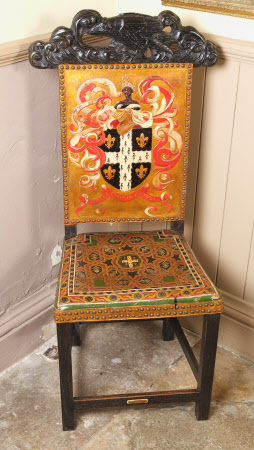Chair
Category
Furniture
Date
circa 1870
Materials
Oak, leather, brass studs
Measurements
115 x 53 x 46 cm
Place of origin
England
Order this imageCollection
Kingston Lacy Estate, Dorset
NT 1254707
Summary
An oak side chair, covered in embossed and painted leather, English, probably circa 1870. With an associated cresting rail carved with a bird amongst foliated scrolls. The back covered in close-nailed embossed and painted leather bearing the coat of arms of Bankes 'Sable, a cross engrailed ermine between four fleur-de-lys or', and their crest 'A Moor's head full-faced couped at the shoulders Proper on the head a cap of maintenance Gules turned up ermine adorned with a crescent issuing therefrom a fleur-de-lys Or' all within a leafy mantling. The seat decorated with the same arms within strapwork. On four plain, square-section legs joined by stretchers. By repute this leather covered side chair was given to Walter Ralph Bankes (1853 - 1904) on his 21st birthday.
Full description
Note on Heraldry: The head of a black person – sometimes crowned, sometimes ‘wreathed’ about the head – appears frequently as a motif (or charge) in medieval European heraldry. In the language of heraldry, the person depicted is described (or blazoned) as a ‘maure’, ‘moor’, ‘blackmoor’ or ‘blackamoor’, and the motif as ‘a maure’s head’ or ‘a moor’s head’, and so on. The term ‘maure’ derives from the Greek work ‘mauros’ meaning ‘black’ or ‘very dark’ and, in the medieval and early modern periods, was an ill-defined stereotype applied to Muslims of the Islamic Iberian Peninsula and North Africa. Usage developed to conflate Muslims of any ethnicity with black Sub-Saharan Africans. The image of the ‘moor’ or ‘blackamoor’ in European heraldry is itself usually stereotyped. Precisely when and where this motif was adopted as an heraldic charge is unknown, but the earliest example is thought to date from 11th century Italy. Its origins may lie in the invasion of Spain and Portugal in 711 by Africa and Arab Muslim forces. In Western Europe, the device may have referred to the black Egyptian St. Maurice, the patron saint of the Holy Roman Empire from the beginning of the 10th century, or to denote participation in the Crusades. Sometimes, in England, the device is used in what are known as ‘canting’ arms, and are incorporated into the arms of a family called ‘More’ or ‘More’, as a pun on their name. Several National Trust properties were, at one time in their history, owned by families whose coats of arms and/or crests incorporated ‘a moor’s head’ as an heraldic charge, and so it appears on objects which survive in National Trust collections. The arms on this chair, granted to the Bankes family in 1613, include ‘a moor’s head' as their crest. ‘Moors’ heads’ also featured in the arms of the Watt family, slave-traders and owners of several Jamaican plantations, who bought Speke Hall in 1795 and who set up their arms in stained glass in one of the windows there. The term ‘moor’ is now considered anachronistic, but it remains part of heraldry’s descriptive vocabulary. It is used here in its historical and heraldic context.
Provenance
By repute this leather covered side chair was given to Walter Ralph Bankes (1853 - 1904) on his 21st birthday. Bequest of the estates of Corfe Castle and Kingston Lacy made to the National Trust by Henry John Ralph Bankes (1902-1981). NT ownership commenced from 19th August 1982.
Marks and inscriptions
Presented by the Tenants of Studland July 1923 (on back of back with Studland weapon)
